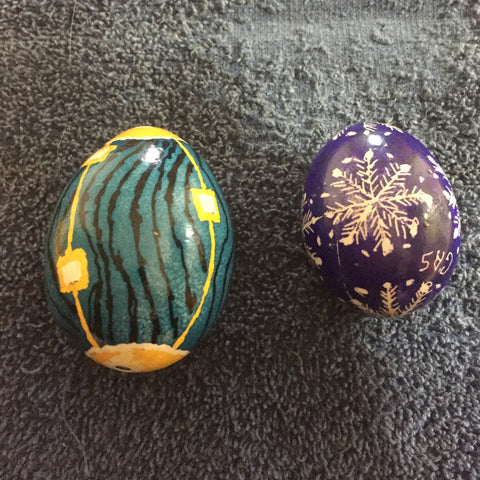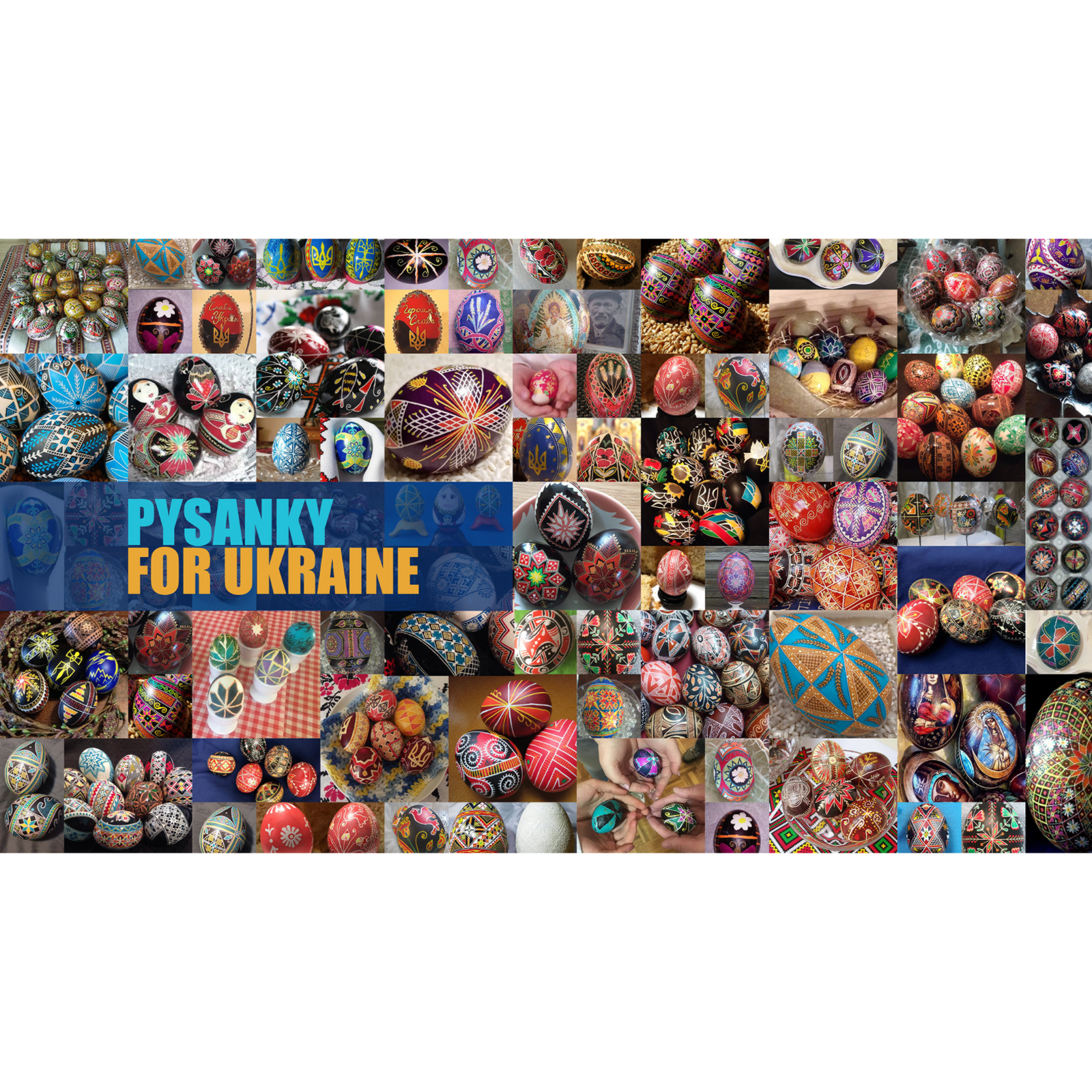Your Cart is Empty
Thank-you for supporting our Fundraisers for Ukraine!
Thank-you for supporting our Fundraisers for Ukraine!
Shop Online
UE Pysanky Retreats
Life Lessons of Pysanky - Don't Worry, Write Pysanky!
December 15, 2017 5 min read
Here before Christmas I took a quick flight from Toronto to Saskatoon and then drove my rental car to Nipawin, Saskatchewan to enjoy some family love with my parents, aunts and uncles and some old school chums.
My mother lives at PineHaven, the only nursing home in town, and my dad lives off on his own near Tobin Lake, 20 minutes from town. I stayed with my dad and drove to town each day to visit mom.
Mom is doing amazing, is loved and well cared for. Small town goodness is alive and well in Nipawin!
While at my dad’s we watched curling, a sport that’s very big in Canada and... dad was introduced to Pysanky.
“Pysanky? What’s that?”“Dad, that’s what we call Ukrainian Easter Eggs”.“Oh... okay. I didn’t know that was their Ukrainian name.”
I gave Dad a Pysanky kit last year so he would see the products we sell plus he’d have a kit just in case he wanted to try the art form himself. A year had passed and the kit never got opened.
During this visit, Dad pulled out the kit, and said, “Sorry, Kap (my dad’s nickname for me) I didn’t try because I had no idea how to start”.
On this trip, I took a few of our new dyes and wax sheets with me and a couple of our new black handled electric kistky with a medium and heavy pen tip size.
Originally I went just thinking that I would show dad some of the products we sell. On many phone calls he would hear me talk about our electric kistky and my crazy dye packing escapades as I would share some of my experiences after taking on Ukrainian EggCessories in 2016.
He knew Baba (my mom’s mom) use to write eggs but didn’t remember ever watching her like I did when I was young. He was probably working when I would go over and visit with her.
I soon realized that dad knew very little of the process of writing a Pysanka. So... late in the evenings, we decided that it was a great time to have Dad write his first. He just started having his own chickens so he has ready access to 14-16 fresh white and brown eggs every day!!!What an opportunity!
There is a lot to consider when wrapping your brain around the steps and process of how the layers of colours go on the eggs and how the wax covers and protects the egg shell when writing your design.
Dad had a ton of questions.How many colours do you use? What dye colour do you start with?Do you put the eggs in the dye for hours? Do you take the wax off after every colour? How do you make straight lines on the egg? Dad shared that he dreamt of a design the night before, “I thought about a picture I want to draw on the egg... but where to start?”
Good questions!
When you are first thinking through how to write a Pysanka the questions can be endless.
There really are a lot of steps and information to take into account when first learning Pysanka.
My advice was, “let’s go slow, write a practice egg, and instead of me telling you everything all at once, we’ll learn as we move through the process”.
With every step along the way, light bulbs kept turning on for Dad. It was fun to watch how he came to appreciate the process of writing and the new found respect he had for this ancient art form.I’m so proud of Dad.
Here are his first ever Pysanky.
The left is his inaugural effort on which he wanted to make black squiggly lines down the egg with latches so it would look like a lock box. The second egg was a snowflake design that he even put his initials on.

Around of applause please!!!
So many lessons learned.
What we learn when writing Pysanky can easily become life lessons as well.
If there was a theme for all our Pysanky lessons - it is not to worry. Everything can be fixed or salvaged if required. Be gentle with yourself. Be patient because in the end, there is always beauty in your creation.
Some of the “lessons” we take from Pysanky:
- Don't worry if you make your hole in the egg too big when emptying your egg. Use wax to plug the hole and when your Pysanky is all finished, look at covering the hole at the end with a Pysanky finding or a fancy metal egg top.
- Even if you don’t hide the hole, people will be so impressed with your finished egg that they won’t even notice it.
- Flaws are beautiful too!
- If you put wax in the wrong spot, again don’t panic. Just change the colour in that area to the colour you are covering. Change up your design a bit. This egg will still be impressive... and if you really want an egg with your original design then you can write another egg!
- Don't worry if your lines aren’t straight or don’t look like you envisioned. Once the egg is dyed and you melt all the wax off, you’ll be amazed at how good your finished Pysanka will look. Even with crooked lines!
- Be gentle on yourself at the beginning. Everyone needs one or two eggs just to figure out the steps and process.
- You can always try again. With Pysanka you always have a second chance... with another egg. 😉
- You’ll be amazed at how fast you pick up the process after a couple eggs.
- If you don’t like or used the wrong colour to dye your egg, don't panic. Either go with the flow and use that colour somewhere or simply wash the dye off your egg and start again. Use some dish soap with an old soft tooth brush. This is called washing back to white. Be careful not to brush too hard so you don’t remove the wax.
Once you’ve gently scrubbed the dye off your egg, dip it in a bath of vinegar water to "reset" the eggshell and make it ready to take dye again. I use 3/4 cup water to 1/4 cup vinegar for my vinegar bath. Again I use the soft old toothbrush to get the vinegar water in all areas of the eggshell. This is especially important if there are lots of small details on your egg -otherwise you might have some areas that don’t dye as strong or brilliant as other areas.
- Always use an egg that is at room temperature. If you pull out an egg from the fridge and start writing on it right away (like my dad did with his snowflake egg), the wax will immediately cool when it touches the egg and won’t lay on nice and smooth. If this happens it’s not your fault or the kistka’s fault - it’s a cold egg. Just stop and let the egg come to room temperature before continuing.
If you have any other tips or lessons learned that you'd like to share, please let us know - we're in this together!
"As I spent this special time with my dad, I couldn't help but think of that classic tune, "Don't Worry Be Happy"... and changed the lyrics slightly to “Don’t Worry, Write Pysanky!!"
Leave a comment
Comments will be approved before showing up.
Subscribe
Sign up to get the latest on sales, new releases and more …

